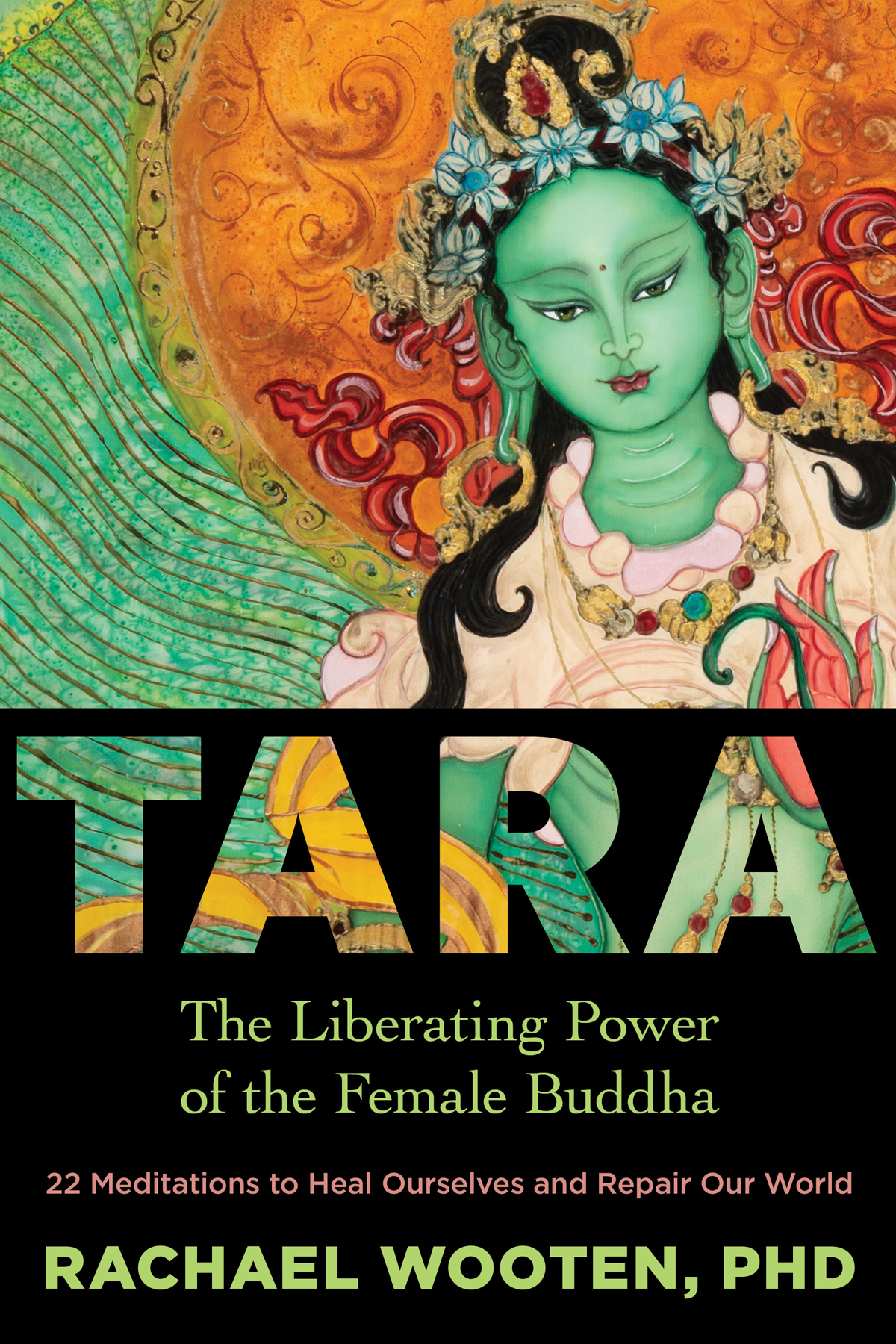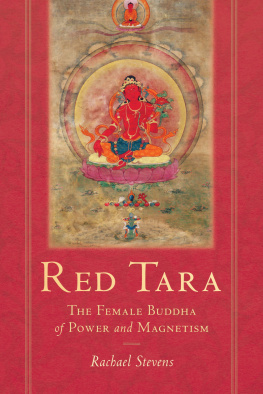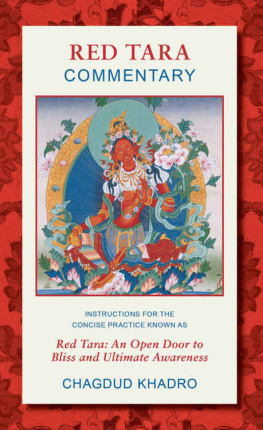Rachael Wooten - Tara: The Liberating Power of the Female Buddha
Here you can read online Rachael Wooten - Tara: The Liberating Power of the Female Buddha full text of the book (entire story) in english for free. Download pdf and epub, get meaning, cover and reviews about this ebook. year: 2020, publisher: Sounds True, genre: Religion. Description of the work, (preface) as well as reviews are available. Best literature library LitArk.com created for fans of good reading and offers a wide selection of genres:
Romance novel
Science fiction
Adventure
Detective
Science
History
Home and family
Prose
Art
Politics
Computer
Non-fiction
Religion
Business
Children
Humor
Choose a favorite category and find really read worthwhile books. Enjoy immersion in the world of imagination, feel the emotions of the characters or learn something new for yourself, make an fascinating discovery.

- Book:Tara: The Liberating Power of the Female Buddha
- Author:
- Publisher:Sounds True
- Genre:
- Year:2020
- Rating:5 / 5
- Favourites:Add to favourites
- Your mark:
- 100
- 1
- 2
- 3
- 4
- 5
Tara: The Liberating Power of the Female Buddha: summary, description and annotation
We offer to read an annotation, description, summary or preface (depends on what the author of the book "Tara: The Liberating Power of the Female Buddha" wrote himself). If you haven't found the necessary information about the book — write in the comments, we will try to find it.
Tara: The Liberating Power of the Female Buddha — read online for free the complete book (whole text) full work
Below is the text of the book, divided by pages. System saving the place of the last page read, allows you to conveniently read the book "Tara: The Liberating Power of the Female Buddha" online for free, without having to search again every time where you left off. Put a bookmark, and you can go to the page where you finished reading at any time.
Font size:
Interval:
Bookmark:
Table of Contents




In deep gratitude for the unlimited and ongoing blessings of my teachers:
Lodr Tulku Lobsang Champa Khedup Namgyal Rinpoche Mother Meera
Rabbi Zalman Schachter-Shalomi. May his memory be for blessing.
With your words, actions, and pure silence, with your remarkable presence and teachings, you have shown me that help is always available from multiple realms of consciousness.
In loving memory of Tara sisters, whose lives touched us all and were far too short:
Sally Comer
Sistie Howie
Elena Matthews
Birgit Patty
Sue Versenyi
As soon as they think of my name, I protect the living beings from the Ocean of the various dangers of existence. Therefore, I am called the Liberator by the victorious Buddhas, all over the world.
These words go directly back to Arya Tara, the female Buddha born of compassion. She shows the way, giving meaning and support to our precious human life.
Lodr Tulku Rinpoche
Wish Fulfilling Tara Island
Switzerland
Contents
A Note on Spelling and Pronunciation
As this book is intended for a general audience, the Tibetan and Sanskrit words herein are not transliterated, but rather spelled informally for ease of reading. The pronunciation spellings of the Sanskrit mantras reflect the journey these practices have taken from India, to Tibet, and now to the West.

Introduction
Welcome to the Mandala of Green Tara! You have entered the realm of a female buddha with the power to appear in any form she wishes in order to help you. Seated on her lotus throne, but ready to leap to your assistance, she is surrounded by her twenty-one different manifestations, each with a particular gift to offer a devotee in need.
The Sanskrit word mandala means to contain the essence. By stepping into Taras sacred circle through meditative practice, you connect directly with her. Taras name perfectly explains her essential purpose. Tara means Star in Sanskrit, referring to the North Star that humans have followed for centuries in the dark night to find true direction. Tara, or Dolma, in Tibetan, also means Savioress, She Who Liberates, the One Who Brings Us Across. She helps us navigate the stormy waters of self-doubt when we question our connection to our basic goodness, or our awakened nature within, and our sense of place in the world around us.
As my teacher, Lodr Tulku Rinpoche, reminded me recently, In the twenty-first century, we need inner stability and peace of mind. Tara is a goddess of compassion and love. Her blessings can pacify our anxieties!
Do you sometimes suffer from anxiety or feel a lack of stability? Do you often feel you need help, but dont deserve it? Do you suffer from shame about perceived flaws and failures? Does fear prevent you from moving forward in life or from having meaningful relationships? Do you withdraw into isolation and suffer alone, instead of meeting your distress with tenderness by reaching out to others, consciously connecting with the natural world around you, or engaging in prayer or meditation? When you are in need, do you wonder, How do I pray? Who will answer?
You are not alone. You are not meant to manage your suffering or that of the world in isolation. Your life is embedded in an intricate web of relationships with countless beingshuman and otherwisesome of them known to you, the vast majority of them unknown to you. Your inner life also unfolds in the context of teachers, friends, loved ones, spiritual teachings and practices, lived experiences, and unseen forces. You are fundamentally interconnected with everyone and everything. A new and profound awareness of this is, above all else, Taras gift to you.
We explore the realm of Tara through sadhana, an ancient and highly ritualized form of meditative practice common to many Eastern religions, including all schools of Tibetan Buddhism. Sadhana practice is a potent tool for working with our emotional and mental states. Through directed intention, embodied visualization and chanting, we engage our whole being to invoke the energy and power of a meditational deity, the enlightened female Buddha Tara, in order to access and activate her positive qualities within us.
Prior to the Tibetan peoples exodus from their homelands following the Chinese invasion of Tibet, such practices were unknown in the West and often only available to those initiated by a qualified teacher. Tara practices are part of a larger body of tantric practices that includes several levels, some of which are still taught only to more advanced students by an experienced teacher. The practices in this book, however, come from a level of tantra freely offered to devotees of Tara, whether or not they have received initiation.
I have had the benefit of many Tara initiations by my teacher, whose full name is Lodr Tulku Lobsang Champa Khedup Namgyal Rinpoche, and have been authorized by him to teach these practices to those with the desire and motivation to learn them. In 1997, Lodr Rinpoche translated a particular text on the sadhanas of the twenty-one Taras by the nineteenth-century Gelug lama, Kalka Damchig Dorje. He has encouraged me to complete this text so as to make the benefits of connecting with Tara more widely available to all.
But who is Tara, and why would we call upon her for help or cultivate her qualities within ourselves?
Tara is known as the beloved female buddha of Tibet, a fully enlightened being dedicated to the welfare of all. Every school of Tibetan Buddhism has its own form of Tara practice. The descriptions of Tara and practice instructions in this book are from the Gelug school, the same root lineage as the Dalai Lamas. They were introduced to Tibetan practitioners by the Indian master Atisha, who is said to have moved to Tibet in the eleventh century at Taras request.
In our day, we commonly see Tara depicted as a youthful green woman seated on a lotus throne with a moon cushion in the center, holding a blue lotus in her right hand, with her right foot stretched out in front of her as though she is ready to leap up at any moment to help us. Tibetans pray to her, in fact, for swift assistance in time of need, much as a Catholic might pray to Mary for her intercession and merciful care. Monks, nuns, and lay-people alike chant the twenty-one ancient verses known as the Twenty-One Praises to Tara on a daily basis. This song cycle opens with an homage to Green Tara followed by the praises to her twenty-one emanations, or different manifestations. It is the basis of the Tara practices that have been the focus of my spiritual journey and deeply informed my psychological counseling work for more than twenty-five years.
Green Tara is famous both for her enlightened activities and for protecting her devotees from all fears. Each of her emanations represents a specific quality of awakened consciousness and offers a particular kind of assistance. For example, White Tara Who Removes All Suffering helps us penetrate the meaning of bad dreams, thus dissolving the fear accompanying them. Red Wisdom Tara helps us contain volatile emotions by understanding what lies beneath them. We gain strength, clarity, and peace in this process. While all of these qualities reside in Green Tara herself, engaging with her various manifestations offers us deep and particular insight into the ways enlightened consciousness functions.
Next pageFont size:
Interval:
Bookmark:
Similar books «Tara: The Liberating Power of the Female Buddha»
Look at similar books to Tara: The Liberating Power of the Female Buddha. We have selected literature similar in name and meaning in the hope of providing readers with more options to find new, interesting, not yet read works.
Discussion, reviews of the book Tara: The Liberating Power of the Female Buddha and just readers' own opinions. Leave your comments, write what you think about the work, its meaning or the main characters. Specify what exactly you liked and what you didn't like, and why you think so.








